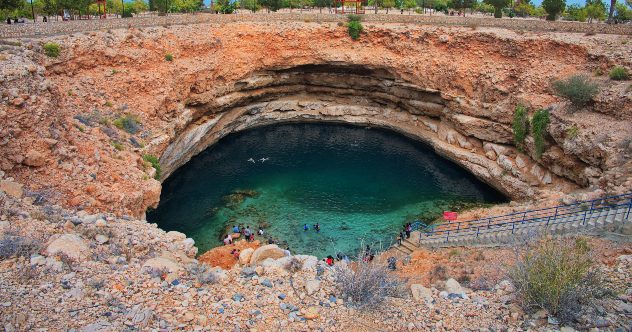1. Forbidden Cape
This cape is called Ryty (Kher-Khushun - angry, angry cape). It is located on the western shore of Baikal opposite the widest. No local will land on the widest part of the legendary lake under any pretext. And for tourists it has also been officially banned for some time now.
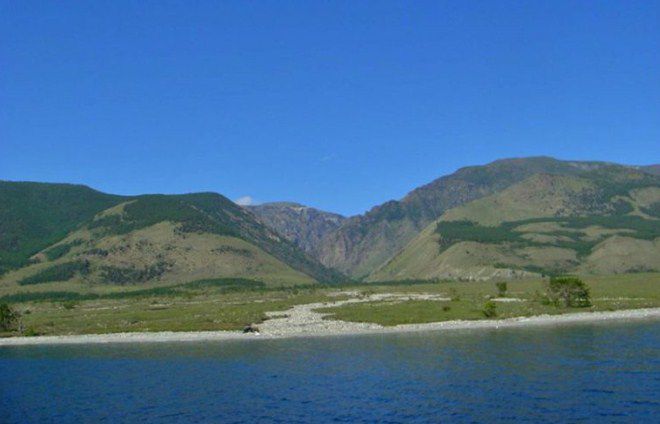
The whole point is that there are ruins of an ancient city left here, the existence of which was not reported in any of the existing sources. Like the recently sensationally discovered South Ural city of the Aryans - Arkaim, it captivates the imagination. from time to time there is an increase in the radiation level for no apparent reason. The local population likes to scare tourists with stories about evil deities who can do various dirty tricks to those who harm the local nature.
They say that heroes who risked cutting down a tree or hunting there often died or disappeared without a trace.
There is a legend that in ancient times there was a settlement here. The surviving wall could allegedly have been part of it. Large-scale archaeological excavations have never been carried out here, so this hypothesis cannot be confirmed yet. Local residents were strictly forbidden to visit Cape Ryty. Old-timers said that an angry spirit Khan-Uher lives here with his sons, who carefully protect the source of the Rita River, where the entrance to the underworld is located. The river valley is considered sacred. Even shamans avoid visiting these places. One of the prohibitions concerns women. They are strictly forbidden to enter here. Moreover, if they sail past this place in a boat, they are not allowed to look at it. Men were also restricted. They had to leave their insoles here (earlier, insoles were made of grass). Hunting in these places was prohibited. Taking anything with you is also not recommended. This even applies to stones. Local residents tell a story about two hunters who, carried away by hunting squirrels and sables, wandered into these places. After that, they lived exactly a year.
In some sources, mystics add information about printed photographs, on which an artificial stone wall was found to have an unusual curvature of space, which could not be attributed to defects in film or photo printing. The camera lens captured an inexplicable spatial phenomenon.
With enviable regularity, equipment breaks down for no reason opposite the cape, devices act up, and cars fall through the ice.
As we approached, it was at this very place that the low-pressure aluminum fuel line on our boat burst, which is almost theoretically unlikely.
Local residents have many legends about Ryty. One of them was told by the Olkhon shaman Valentin Khagdaev. Once upon a time, a dispute about shamanic power broke out between the Evenki, Yakut and Buryat clans. A shaman and a hero from each clan came out to the great battle. However, no one defeated anyone in this fight. But the battle awakened the spirit of the ruler of Northern Baikal Ukher-noyon buried here, and a terrible mudflow rolled down onto the fertile plain, mixing all the land with huge stones. Previously, there was a tradition to go to the cape every three years to perform a special sacrifice rite to the spirit of Ukher-noyon, so that he would have mercy. Only the shaman was allowed to reach the sanctuary. Shamans prayed on a "black" (moonless) night on an inverted black cauldron. But the tradition was broken, and now the spirit takes revenge on all people visiting this area.
2. Shaman stone and its power
Few people remember the origins of the stone's name. According to legend, this is the place where the owner of the Angara lived. But an even more ancient story says that Father Baikal wanted to marry his daughter Angara to the handsome Irkut. But the daughter ran away to the Yenisei and the angry father threw a rock after the fleeing woman.
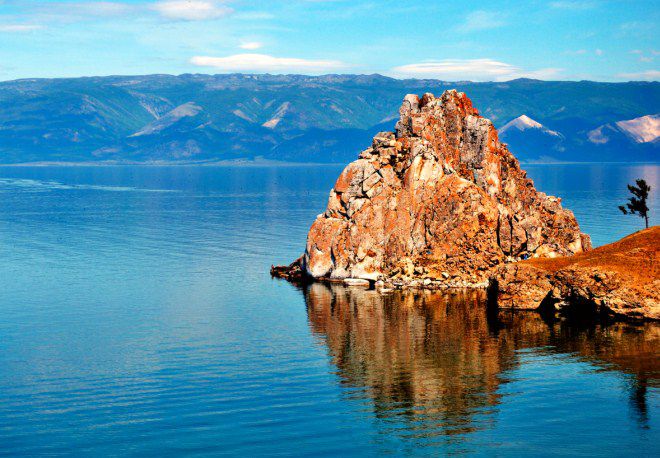
The stone is considered a place of power, so various shamanic rituals are often performed on it and oaths are taken. It used to be used as a crime detector. Accused criminals were left on this stone overnight and acquitted if it was not washed away by the waters of Lake Baikal by morning.
The mystery of this place is based on many legends and stories, according to which ancient Buryat shamans used this rock as a place of sacrifice, and ancient aborigines revered the Shaman Stone as the home of the master of the Angara - Ama Sagan Noyon (many legends and myths can be found about him in the Buryat epic).
The most beautiful legend about the appearance of this stone is connected with ancient times, knights and tragic love.
In those days, Baikal was a personified entity that symbolized the wealth and grandeur of these lands. And, according to legend, he had a daughter who was considered the most beautiful girl, before whom everyone fell prostrate. As befits a beauties, Angara demanded attention, but was proud and willful. And when the time came to marry her off, Baikal's father decided to hold a heroic tournament in honor of the celebration of Surkharban in the summer, in which the winner received the heart and hand of the beauty.
At this tournament, the father showed his favoritism to a young warrior named Irkut. But the more often the father spoke about him, the more stubborn Angara became, who took a fancy to another warrior, the handsome Yenisei, who had won all the battles. However, the father did not give his consent to their marriage, trying to persuade his daughter to marry Irkut. After numerous attempts, Baikal became indignant, drove Yenisei away, locked Angara in prison and answered for her by consenting to young Irkut. When the girl heard this news, she called her brothers, the streams, for help and ran away with her beloved. Father Baikal was in terrible anger, he caused a storm, from which all the animals trembled.
To stop the obstinate girl, Irkut ran after her, and the angry Baikal threw a piece of broken rock after her to block the way. However, she fell behind Angara, and Irkut managed to grab her only by the edge of her wedding veil. The girl fell into the arms of her beloved Yenisei, and now they will be together forever.
And the rivers and lakes became full-flowing, because the groom Irkut and father Baikal cried bitterly, and the lovers Yenisei and Angara happily shed tears. And that very fragment, thrown by the hand of the father, is the Shaman-stone, marking the border between the stepfather's house and the runaway daughter.
By the way, there are several versions of this legend. According to one, it was not a tournament, but Angara simply learned from migratory birds about the handsome Yenisei and wanted to run away to it. And a more tragic version has the following ending: a rock fragment fell into Angara and it did not go to anyone: neither Yenisei, nor Irkut, nor Baikal, now located between them.
3. Cape Khoboy or Dragon's Fang
The spectacular columnar rock, resembling a sharp fang from the sea side, has a pronounced resemblance to the profile of a woman's head with a bust, as on ancient Greek galleys.
According to legend, the Khoboy rock is considered by locals to be a fang that a dragon once lost. But scientists have entered into a dispute with them and claim that it is simply a piece of a meteorite. But in any case, this place is considered scary for tourists because here you can meet the spirits of deceased people who have recently died. Shamans can also help you see your past incarnations. But whether a mere mortal can withstand this is still questionable.
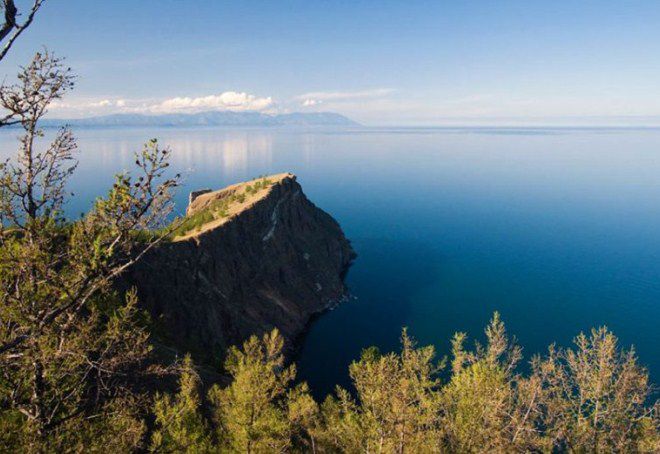
There is a Buryat legend, according to which this is a petrified Buryat woman, who, out of envy for her husband, asked the Tengris for the same palace as the one granted to her husband. The Tengris, saying: "As long as there is evil and envy on earth, you will be a stone," turned her into a rock. The place is notable for its polyphonic echo, which is reflected from the monolithic rock. Rare and relict herbs are found here. In winter, you can see the grottoes, fabulously decorated with splash ice and transparent icicles.
4. Shamanka Mountain is terrifying
Shamanka Rock inspires even more fear than Mys Ryty. This marble-granite-quartz mountain was named "stone-temple" and they say that it does not allow just anyone to approach it. Like everything mystical around Baikal, this local landmark also communicates only with shamans.
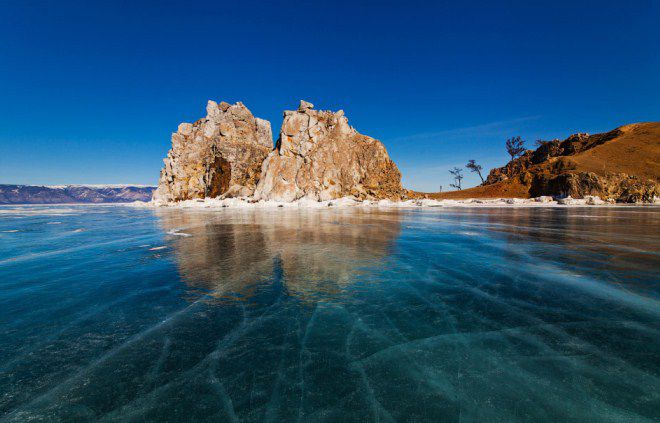
Such fear and secrecy are usually due to legends. They say that long ago this place caught the eye of 13 divine beings. But not all of them were peace-loving. One of the most evil ones stood out and became the soul of this block. Women were forbidden to even approach it under pain of death. And the most powerful magicians come to this place for the gift of foresight, but apparently not everyone is given it.
Shamanka Rock on Olkhon Island is one of the nine Asian shrines. It has become not only the calling card of this place, but also the most famous image of the lake: it is always depicted in every film or photograph. The cave, which was formed under the influence of water and wind, has become the most revered holy place in the entire region. It was here that sacrifices took place, and the very first shamans came here to make vows.
Any local resident will gladly tell you that there is a mystical meaning. They will immediately cite an ancient legend as an example, which told of 13 northern sons of divine rulers who decided that it was necessary to pass judgment on the human race, descended to earth, having previously chosen several places for their residence. Khan Khute-baabai (Khan Hoto-babai) was the oldest and the strongest. He settled in a cave on Shaman Cape on Olkhon Island.
According to the Olkhon elders, the son of the divine ruler has three castles: in the sky, on the earth and underground. According to the legend that locals love to tell over a cup of evening tea, Khan Khute-baabai became the king of all shamans, choosing Olkhon Island as his permanent residence. He declared himself not only the master of the island, but also began to protect it and patronize all the shamanic religions of the north. People revered him so much that when passing by the cave and cape, they did not allow themselves to use a horse. If they were in a hurry, they would ride only to the cape, then dismount, wrapping their hooves with various materials so that the clattering would not be heard. But even after that, they walked past the cape and the cliff, leading their horse behind their backs so as not to disturb the Great Spirit.
Shamanka Rock is sacred. It contains a through cave, which only shamans could enter. This territory was forbidden for a long time, and people did not approach it solely out of superstitious fear. However, today any tourist can walk through this cave and appreciate its scale.
Women were forbidden to approach the cape, and they would go around the place for 2 miles. According to one version, the prohibition for women to pass through the cave is connected with the belief of ancient people that the presence of “unclean and sinful” women could desecrate the purity of the sacred place. According to another version, this prohibition protected women, since it was believed that visiting the cave could complicate childbirth - and there would be no offspring. In the modern interpretation of sacred places, such a prohibition can be explained by the fact that places where people have believed and worshiped for a long time acquire powerful energy that can affect a person. You cannot desecrate a sacred place with any bad thoughts or deeds, you cannot appear here drunk and have a loud conversation.
This is one of the rare places that has not been desecrated by subsequent generations. The ban on visiting this place especially concerns children. According to shamanists, if a child is sensitive from birth and not prepared to meet spirits, the accumulation of great emotional energy and a huge number of spirits of the "ghost palace" can cause unpredictable consequences. When visiting a sacred place, it is important to remember that the spell of ancient shamans has always been effective. Do not desecrate the rocks with inscriptions and breaking bottles, bad words and thoughts.
5. Majestic Bogatyr, Lord of the Elements
This cape was previously called Fiery, because it was first discovered to be not very hospitable. It greeted travelers with a pillar of fire, which prevented them from landing on the shore. No one has ever found an explanation for this and other phenomena that were observed here.

Nowadays it has been renamed Bogatyr, who, according to local beliefs, is waiting for his master, who will be able to take control of the elements of fire, air and water. Until recently, even babies were brought there so that they would gain physical strength and longevity.
According to the Buryat shaman Uirbek, rituals associated with the invocation of the elements of power: fire, wind and water, are held on Cape Bogatyr. Until the first quarter of the 20th century, it was customary for the leaders and elders of local tribes and villages to bring newborn male babies to the cape. It was believed that once in this place, the future leader or warrior would gain special physical and spiritual strength and longevity.
6. Lake Shara-Nur and its monster
Every lake that is shrouded in mystery in one way or another always has a native inhabitant. Baikal has such a lake. Shara-Nur boasts a huge yellow snake Shara-Kaa. Every year dozens of people disappear on this lake. Whether the beast is to blame or too careless swimmers is unknown, since not a single search expedition finds either the culprit or the bodies of the missing.
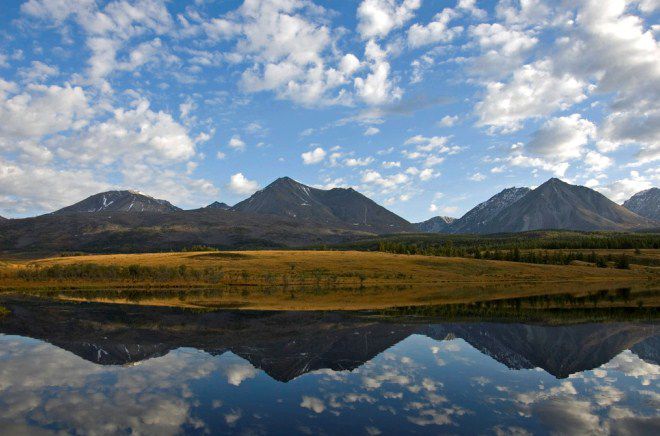
The only place where the unknown beast retreats is a network of tunnels and underwater caves that scientists have discovered. Two lakes are connected by them. Fishermen often hear strange sounds, similar to breathing and moans, and attribute them to the lake's talisman.
The lake is surrounded by a pine forest, the pines literally saturate every inch of air with a healing resinous smell. Thyme blooms along the shores of the lake, reeds grow. A beautiful legend is associated with the lake. A brave hunter stole the wings of a swan princess while she was splashing in the waters of the lake and agreed to return them to her in exchange for marriage. Another legend tells how a hunter was chasing a wounded animal, and suddenly the surface of the lake opened up before them, the deer rushed into the water and came out on the other side of the lake completely healed from a terrible wound. Since then, people have come to the lake to treat their ailments.
When you get to the lake, you pass a larch tree on the road, the roots of which are completely exposed, the tree grows in an unthinkable inclined position and rests on its own grown branches. There is also a local legend associated with this tree. Once a local strongman passed by the tree, to prove his strength he pulled out the larch with his bare hands and stuck it back, but only with the branches down. The hero's name was Khanshai and he is something like Ilya Muromets for the Buryats. The legend says that he easily moved huge stones, and even threw some far into the steppe.
The phenomenon of the so-called "witch circles" is also interesting. On the slopes of the lake there are very wide, sometimes reaching several meters, ring-shaped formations. It looks as if someone deliberately trampled the grass, circling crazy round dances. Local Buryats are convinced that this is not without the machinations of evil spirits. However, scientists explain this phenomenon simply and prosaically - it is ordinary mold, the mycelium of moldy mushrooms. In conditions of high humidity, the mycelium grows on the slopes in regular circles.
7. Guardians
In Soviet times, military intelligence officers discovered strange three-meter-long creatures in the waters of Lake Baikal during training exercises. When they tried to approach them, three were injured on the spot, and four of the expedition members were left disabled. After that, the military added Lake Baikal to the list of waters dangerous for diving.
One day, after another dive, the reconnaissance divers reported to the command that they had seen unknown underwater swimmers at depth - as is well known, the water in Lake Baikal is amazingly transparent. The divers reported that they had encountered the mysterious swimmers more than once, but for fear of being "misunderstood" they did not report it. According to them, the unknown divers did not have any hoses or cylinders on their backs. They wore silver-colored tight-fitting diving suits, somewhat reminiscent of fish scales, and large spherical helmets on their heads. The main thing, our reconnaissance divers unanimously claimed: the unknown underwater swimmers were real giants, much taller than the average human. Of particular interest and curiosity was the fact that our reconnaissance divers encountered the unknown "underwater humanoids" at depths of approximately fifty meters and could move in this thickness of water with amazing speed.
Catching spies and saboteurs has always been one of the favorite activities of the special departments of our army and navy. Therefore, the command made a "wise" decision to try to detain and capture unknown persons who were observing the area of underwater training of military divers. The authorities understood that in any case they did not risk anything: if they detained the "spies" - orders and stars would rain down on their shoulder straps, it would turn out that no "silver overalls" existed - the divers would be punished for spreading panic rumors.
The command had no doubts about the success of the planned enterprise - the reconnaissance divers were excellently trained. A special capture group was created from them, including seven people led by an officer. They were tasked with capturing one of the "unknown swimmers", for which they were supposed to use a tried and tested method with a net: the enemy would get entangled in it and become prey to the attackers.
During the next dive, the capture team quickly discovered giants in silver suits, got closer to one of them and tried to throw a net over him. What happened next, no one could have predicted. A powerful impulse of unknown origin threw the attackers to the surface of the water at a terrible speed. There was a sharp pressure drop, which could not pass without a trace: three divers died, and four were permanently disabled. The mysterious "ichthyanders" in silver suits simply disappeared.
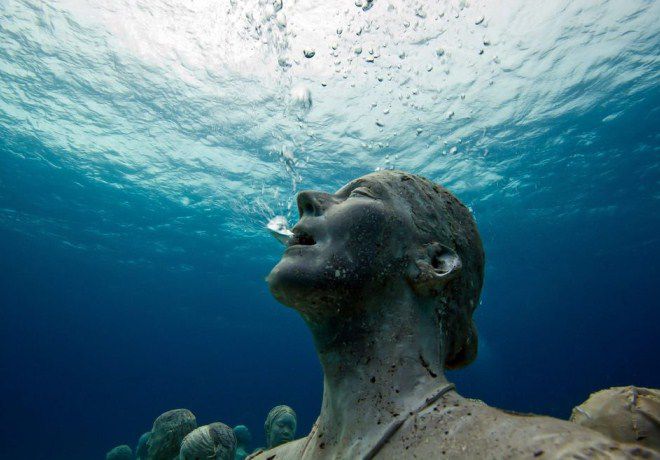
After this tragic incident, the high-ranking army brass was convinced that they were not being deceived. An order was issued by the commander-in-chief of the ground forces on the need to exercise extreme caution when diving into certain bodies of water, especially deep water. The order provided a detailed and precise list of such bodies of water where, according to experts, the appearance of various "balls", "disks" and similar mysterious objects had been repeatedly noted: they were immersed in lakes and launched from the water. Unfortunately, no one managed to obtain the text of this secret document. After the order of the commander-in-chief, the mysterious phenomena did not disappear and did not cease. However, their secret remains unsolved.
Some sources mention that the bottom of the lake is an abandoned city that sank under water, and presumably those seen by the military are actually the guardians of the crystals of this city.
8. The Devil's Funnel of Baikal
Local fishermen avoid two square kilometers of Lake Baikal. Good weather is no reason to be safe. The calm surface of the lake wakes up and turns into a funnel that sucks everything into itself.
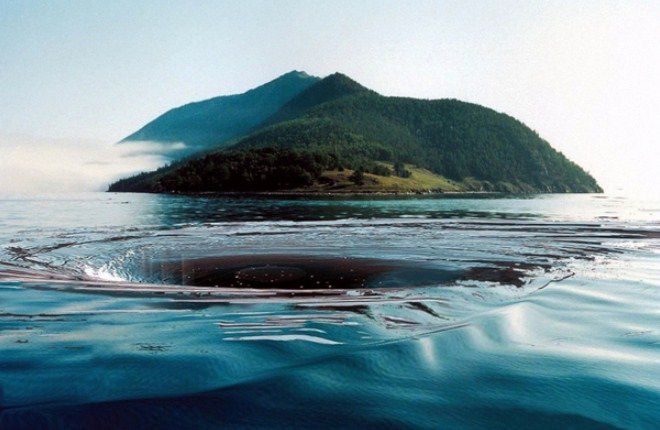
Based on the already mystical atmosphere created by local residents, probably to attract tourists, shamans came up with an explanation for this funnel. They say that this is the gate to the other world for the souls of people. A fisherman who miraculously survived this funnel says that he heard groans and voices. And above the funnel, according to him, the air turned crimson.
Scientific explanations offer several versions of the causes of the phenomenon. One of them considers the assumption of local failures of the bottom of Lake Baikal with the formation of cavities quickly filled with water, which leads to the formation of a whirlpool on the surface. This theory is supported by the high tectonic activity of the region: in January 1862, as a result of a huge failure of the coastline, a new bay was formed, which received the characteristic name "Proval".
Another theory suggests that it is at the place where the funnel is formed that a collision of two local countercurrents occurs. The direction and strength of these currents depends on the time of year and the weather, so that under certain conditions the water flows move strictly towards each other. Such an interaction of countercurrents can indeed lead to very powerful whirlpools. Until now, there has been no detailed study of this theory, so it is more likely to be considered as an assumption.
9. Peretolchin volcano
The volcano got its name after a scientist who had come to study long-extinct volcanoes died near it. His body was found only a year later. Based on the fact that his expedition belongings were untouched and a strange crack divides his skull in half, the real cause of death could not be established.
Peretolchin's body lay next to the path, but it was not found for a long time. According to one hypothesis, volcanoes have an abnormal flow of time. A person can end up in another dimension or another time. According to a similar hypothesis, death occurs at the border of time zones, when human organs work at different speeds.
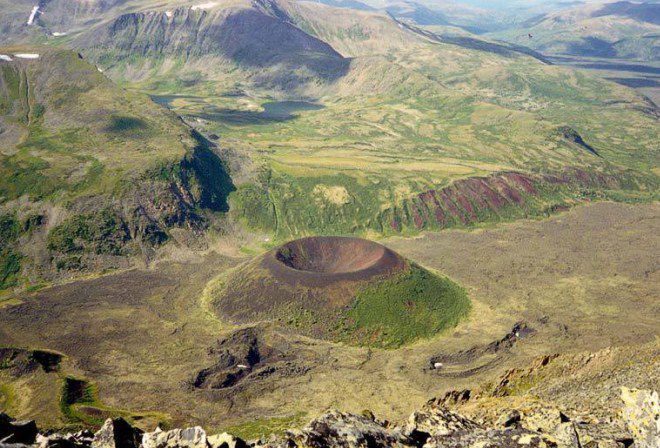
In places where the earth's crust is broken, accidents occur more often, and human health deteriorates. Geopathogenic zones emit negative energy, changing the electromagnetic field.
The Earth's magnetic field is formed by hot magma located deep underground, but in volcanoes the magma is closer to the surface.
Peretolchin volcano impresses with its grey fields of heaving and solidified lava. It seems as if you are seeing the surroundings after explosions.
Ancient civilizations arose and perished on the fertile land near volcanoes. In the legends of many peoples, the former inhabitants went underground, but unusually skilled craftsmen sometimes appear to people (dwarfs-ore prospectors in Europe, the queen of the Copper Mountain in the Urals). The Yeti, according to the legends of the local Soyots, is found near the Sayan volcanoes. They said that he could kill a person from a distance, without showing himself to his eyes.



